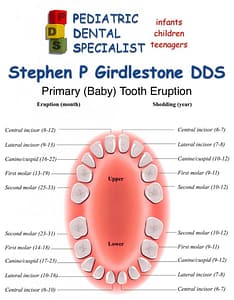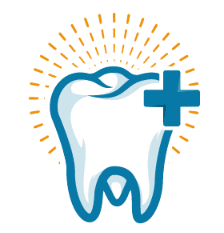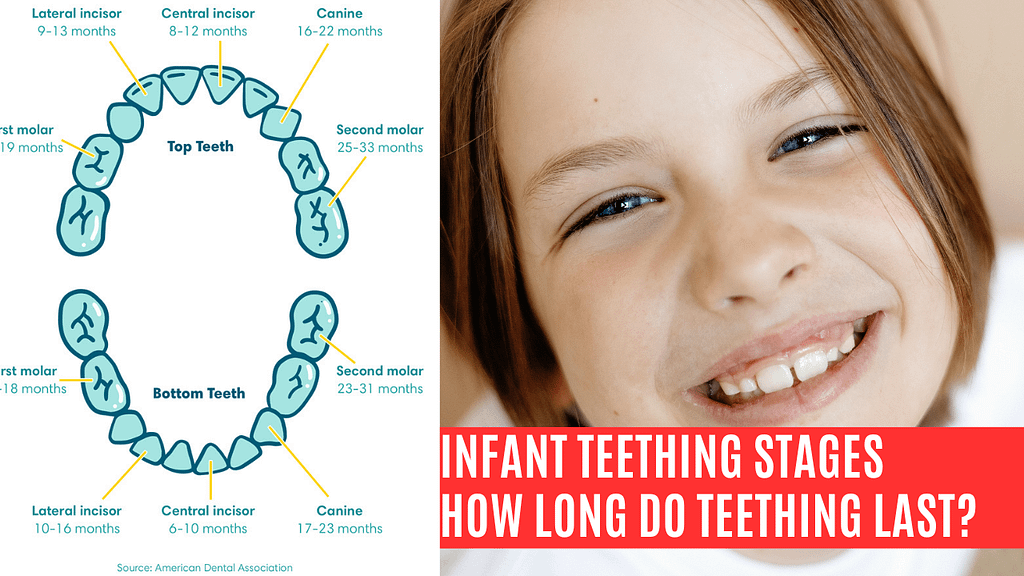Parents often find it challenging to navigate through the infant teething stages as it is marked with sleepless nights. Baby first tooth symptoms include pain, constant drooling, and irritability. To relieve your child’s pain and ensure proper dental formation, it is essential to know these stages.
This makes all the difference from gum irritation signs to molars coming up while you understand your baby’s needs.
Don’t be overwhelmed by this period—arm yourself with knowledge and remedies that work to alleviate your little one’s discomforts. Start exploring the essential stages of teething gums, teething baby home remedies, baby gums before and after teeth eruption, and much more.
Moreover, there are many home remedies for parents of a teething baby. Follow our blog for more remedies and oral directions about caring for babies’ teeth, using a pacifier, fingerbrush, and much more.
Read more: 5 Ways to Manage Dental Phobia and Anxiety in Kids
Why to Understand Infant Teething Stages?
There are several reasons for early teething in babies. Parents must know the different stages of teething pictures to support their children through this challenging developmental phase effectively.
It helps them anticipate when their babies will start growing teeth and how they will manifest the signs of teething s.
Awareness of development periods helps inculcate good dental practices from a young age, promoting healthy teeth development. This information allows parents to offer appropriate care and comfort for their teething children.
What are Infant Teething Stages?
Interestingly, studies reveal that babies may be born with one or two teeth in 1 in 6000 to 1 in 800 cases. However, there are five main teething stages in infants. The stages are as follows:
- Pre-Teething
- Early Teething
- Middle Teething
- Molar Emergence
- Completion
Stage 1: Pre-Teething (0–6 months)
Newborns are born with 20 primary teeth behind the gums, even if they are not yet visible. Because a baby’s diet at this period often consists of milk alone, these are commonly called “milk teeth.” At this time, teeth typically do not erupt.
Stage 2: Early Teething (6–8 months)
Usually, the lower middle incisors are the first to erupt through the gums. When they do so, babies are aged about six to eight months.
During this time, there is often discomfort due to teething, increased saliva production, and a tendency for the child to bite objects when placed in his mouth.
Providing the baby with chilled teething toys and massaging their gum gently can be of much help.
Giving babies suitable chew toys will help to relieve their discomfort because pressure on the gums reduces pain and diverts their attention.
During this period, the baby’s drool will grow noticeably. Therefore, it will be easier to keep their chin dry if the infant wears a little bib. This can lessen the discomfort by preventing a rash around the baby’s mouth and chin.
Stage 3: Middle Teething (8–12 months)
This phase in infant teething stages involves the growth of more teeth on both the upper and lower jaw, like central upper incisors and lateral incisors. The infant may become grumpy and sleep less peacefully. Cool, wet towels or teething biscuits can be comforting as these teeth come out.
Moreover, fever, diarrhea, and mild appetite loss are typical during this time for babies. A newborn may have more irregular or “off” sleep schedules during stage 3.
During teething gum stages, it is common for parents and newborns to experience sleeplessness at night. See your pediatricians for recommendations on over-the-counter pain relievers if your baby appears to be in excessive discomfort or worsening pain.
Stage 4: Molar Emergence (12–18 months)
The first molars emerge at this point, which causes great pain because they are more significant than the other teeth found at the back part of the mouth where they are located. In addition, it can make them more irritable and disrupt their eating patterns, including changes in sleep habits.
A pediatrician’s advice concerning chilled teething toys and over-the-counter pain relievers could work fine.
Stage 5: Completion (18–24 months)
The appearance of canines and second molars usually completes the primary teeth. This concluding teething stage has symptoms that appear similar to previous stages but are far worse off mostly.
This infant teething stage might be the most excruciating for sure kids. This is when the big molars erupt. These are the largest teeth, so parents may discover their go-to calming methods no longer work. To calm the youngster, try a variety of techniques until one works.
Giving a toddler a tricky vegetable to chew on is something many parents find helpful, and it’s also healthy. When employing this technique, monitor the youngster closely to prevent choking!

10 Ways to Soothe Pain in Infant Teething Stages
Follow these simple and easy ways and home remedies to ease the pain during the teething process.
- Massaging the Gum: To alleviate pain, kindly caress your baby’s gums with a neat finger.
- Toys for Teething Period: Give your child safe, soft teething rings or toys.
- Cold Remedy: Put a chilled (not frozen) teething ring or cold wet cloth on swollen gums.
- Teething Foods: Offer babies hard foods, such as biscuits, that are okay to chew.
- Fun Activities: You can distract children from discomfort using distractions and games
- OTC medicines and gels: Your pediatrician may recommend you apply some over-the-counter gels and analgesic drugs meant for infants
- Extra care: It is better if parents give their children more kisses and hugs and make them feel safe during this distressing moment.
- Maintain Hydration: Ensure your baby is well-hydrated, particularly if they are drooling excessively.
- Soft foods: to alleviate pain, give your children soft foods such as smoothies and yogurt
- Bibs: Placing a fresh, dry bib or cloth beneath the baby’s chin will help prevent skin irritation from the increased saliva produced by a teething baby.
Bottom Line
To offer adequate reassurance and comfort during this tumultuous period, one must comprehend the stages of infant teething.
New parents could use this knowledge to apply suitable calming methods for their infant’s teething stages as they keep an eye on their child’s oral health right from the start of the eruption of incisors till the complete emergence of molars.
Being ready and proactive through the various stages, starting with the early appearance of incisors and ending with the final emergence of molars, makes things easier for infants and parents.
Welcome this developmental phase; knowing each new tooth signifies a step towards your child’s flawless smile.
Read More: Why Baby Teeth Are Important?
FAQs
What are the five stages of teething?
Baby teeth typically erupt in the following sequence: lower central incisors, upper central incisors, lateral incisors, first molars (upper and lower), canines, and second molars (upper and lower), completing a set of 20 primary teeth by around age 3.
What is the most painful stage of teething?
Stage 5 is the most painful teething stage in babies. This stage starts from 25 months and stays till 33 months of their age and it is hurting for babies as the large molars erupt.
What are the worst symptoms of teething?
The worst teething symptoms can include irritability, fussiness, swollen gums, excessive drooling, and difficulty sleeping, often accompanied by a desire to chew on objects to relieve discomfort.
At what age do babies change teeth?
As per the tooth eruption chart, baby teething age starts from 4 to 7 months. However, babies change teeth at the age of 6, and in the upcoming years, deciduous teeth become wobbly and leave spaces for new ones.
What is the most painful among infant teething stages?
The answer is stage 5(25–33 months), Also known as The Molars’ Revenge! This is the most painful teething stage for some children, as the molars are the biggest teeth.
How long do teething last in babiesS?
The duration required for a tooth to erupt has yet to be precisely determined, but most experts have calculated that it can occur between one and seven days per tooth.
How many teeth should my baby have, and when?
Infants typically have 20 baby (primary) teeth at birth, which begin to erupt (fall out) at six months.


